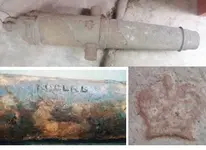Ok, this is complicated.
The earliest carronades- 1770s-80 had trunnions. If you looke here
http://home.att.net/~ShipModelFAQ/ResearchNotes/smf-RN-Carronade.html Figure 3
and look at the top of the three carronade drawings, this gun is an proper carronade. You can see it does not have nozzle, but a short of flat muzzle. IThey are short, fat guns- just a mortar on its side; it does not have the loop at the breech, but a square cascable for a wrought-iron handle. They come in the smaller calibres- 12 and 18 pounders. They are all made by the Carron Company of Scotland, and the trunnions have the word CARRON, a serial number and date on one trunnion and the calibre on the other. This is the sort of carronade recovered from the wrecks off Australia, the Sirius and Pandora
During the late 1770s and early 1780s, during our unpleasance with our American friends, the carronade went through a drastic design change. They now made much large calibre carronades up to 6, they do not have trunnions but a loop under the barrel, the pyramidal breech and cascable loop. It was a little longer in relation to the calibre of the first carronades, and a nozzle was added because the sailors complained the short muzzled allowed the rigging to be set on fire. By the end of the American Wars, the carronade proper as we know it had been developed- it's the third drawing in the site above. If you turn a proper carronade upside down, you can find the flat plane with the Carron name, date and calibre engraved underneath. During the French Revolutionary wars, other British ironworks made carronades as well as Carron
Cannons are not just used by government navies. Merchant ships, and people who live in vulnerable positions liked to have some thing to defend themselves, but they don't need a big gun- they need something light and manoueverable, and cheap. Small iron foundries cast short guns- typically 6 pounders of 4 or 5 feet long. As the carronade became more popular they copied some of the features of the carronade- the nozzle, the breech, but they kept the trunnions and produced a sort of hybrid gun, which is often called a gunnade or cannonade.
Smithbrown




